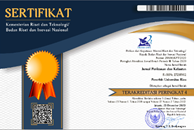Utilization of Cabbage as an Artificial Feed Material for Pearl Catfish (Clarias gariepinus) Fry Growth
(1) Prodi Akuakultur, Fakultas Perikanan dan Ilmu Kelautan, Universitas Mulawarman
(2) Prodi Akuakultur, Fakultas Perikanan dan Ilmu Kelautan, Universitas Mulawarman
(3) Prodi Akuakultur, Fakultas Perikanan dan Ilmu Kelautan, Universitas Mulawarman
(*) Corresponding Author
Abstract
Keywords
Full Text:
PDFReferences
Agromedia, R. 2007. Cara Praktis Membuat Kompos. AgroMedia.
Agustono, W. Permatasari, Y. Cahyono. 2009. Pemberian pakan dengan energy yang berbeda terhadap pertumbuhan benih ikan kerapu (Cromileptes altives). Jurnal Ilmiah Perikanan dan Kelautan, 2(1).
Akbar, J. 2021. Pakan Ikan Berbasis Bahan Baku Gulma Itik untuk Pembesaran Ikan Papuyu. Lambung Mangkurat University Press. 85 hlm
Andriyanto, S., Tahapari, E., dan Insan, I. 2012. Pendederan Ikan Patin di kolam outdoor untuk menghasilkan benih siap tebar di waduk Malahayu, Brebes, Jawa Tengah. Media Akuakultur, 7(1), 20-25.
Dughita, Y.A.F.G.T.P.A. 2018. Pemanfaatan Limbah Organik dari Rumah Makan Sebagai Alternatif Pakan Ternak Ikan Budidaya. Jurnal Agronomika, 13(1): 210-213
Effendie, M.I. 1997. Biologi Perikanan. Yayasan Pustaka Nusantara, Yogyakarta. 93-105 hlm.
Extrada, E., H.T. Ferdinand, dan Yulisman. 2013. Survival and Growth Rate of Snakehead Juvenile (Channa striata) at Different Levels of Water Elevation on Rearing Media. Jurnal Akuakultur Rawa Indonesia, 1(1): 103-114.
Godam, 2012. Isi Kandungan Gizi Rebon Kering–Komposisi Nutrisi Bahan Makanan. http://www.organisasi.org/1970/01/isi-kandungan-gizi-rebon-kering-komposisi-nutrisi-bahan-makanan.html (Maret 2019)
Hartini, S., A.D. Sasanti, F.H. Taqwa. 2013. Kualitas Air, Kelangsungan Hidup dan Pertumbuhan Benih Ikan Gabus (Channa striata) yang Dipelihara dalam Media dengan Penambahan Probiotik. Jurnal Akuakultur Rawa Indonesia 1(2) : 192-202.
Iswanto, B., Suprapto, R., Marnis, H., dan Imron. 2015. Karakteristik morfologis dan genetis ikan lele Afrika (Clarias gariepinus Burchell, 1822) strain Mutiara. Jurnal Riset Akuakultur 10 (3) : 325-334.
Kamaruddin, K., Usman, U., dan Tangko, A.M. 2008. Persiapan dan Penyusunan Bahan Baku Lokal untuk Formulasi Pakan Ikan. Media Akuakultur, 3(2), 150-156.
Kordi, K.M.G.H., 2010. Budidaya Ikan Lele di Kolam Terpal Lebih Mudah, Lebih Murah, Lebih Untung. Andi Offset. Yogyakarta. 107 hlm.
Lutfiyanah, A., & Djunaidah, I. S. 2020. Kinerja Usaha Budidaya Ikan Lele (Clarias sp.) di Kelompok Tani Lele “Mutiara” Desa Kaligelang, Taman, Pemalang. Jurnal Penyuluhan Perikanan dan Kelautan, 14(3), 267-281.
Pratiwi, R. K.W. Hidayat, Sumitro. 2020. Production Performance of Catfish (Clarias gariepinus Burchell, 1822) Cultured with Added Probiotic Bacillus sp. on Biofloc Technology. Journal of Aquaculture and Fish Health, 9(3)
Putri, D.U, Aliyas, Nurjaya. 2019. Pengaruh pemberian pakan dengan dosis berbeda terhadap pertumbuhan dan kelangsungan hidup benih ikan lele (Clarias sp) dalam media bioflok. Tolis Ilmiah : Jurnal Penelitian 1(2):92-100
Rusdiana, S., dan Praharani, L. 2018. Pengembangan peternakan rakyat sapi potong: kebijakan swasembada daging sapi dan kelayakan usaha ternak. In Forum Penelitian Agro Ekonomi. 36(2): 97-116.
Rushad, E.R, S. Sentosa, Z. Hasyim. 2016. Pemanfaatan limbah sayur kubis Brassica olivacea dan buah papaya Carica papaya sebagai pakan cacing tanah Lumbricus rubellus. Jurnal Biologi Makassar, 1(1).
Saputra. I, W.K.A, Putra, T. Yuharto. 2018. Tingkat konversi dan efisiensi pakan benih ikan bawal bintang (Trachinotus blochii) dengan frekuensi pemberian berbeda. Jurnal of Aquaculture Science. 3(2):170-181
Sitorus, S. 2019. Pemanfaatan tepung limbah sayur sawi dan kubis yang difermentasi dengan Rhyzopus sp dalam pakan benih ikan gurami (Osphronemus gourami). Fakultas Perikanan dan Kelautan. Universitas Riau.
Suyanto, S. R. 2006. Budidaya Ikan Lele. Jakarta : Penebar Swadaya.
Vitule, J.R.S, S.C, Umbria, J.M.R, Aranha. 2006. Introduction of African Catfish Clarias gariepinus (Burchell) into Southern Brazil. Biological Invasion. 8:677-681
Wibawa, A.A.P., I.W, Wirawan, I.B.G, Partama. 2015. Peningkatan nilai nutrisi dedak padi sebagai pakan itik melalui biofermentasi dengan khamir. Majalah Ilmiah Peternakan,18(1).
Yuniarti. 2009. Teknik Produksi Induk Betina Ikan Nila (Oreochromis niloticus) Tahap Verifikasi Jantan Fungsional (XX). Jurnal Saintek Perikanan, 5 1) : 38-43.
Article Metrics
Abstract view : 175 timesPDF - 103 times
DOI: http://dx.doi.org/10.31258/jpk.27.2.192-200
Copyright (c) 2022 Komsanah Sukarti, Henny Pagoray, Andi Nikhlani

This work is licensed under a Creative Commons Attribution-NonCommercial-NoDerivatives 4.0 International License.
Gedung Marine Center Lt 2. Fakultas Perikanan dan Kelautan Universitas Riau



